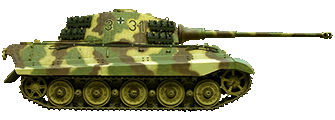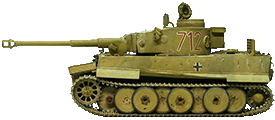



Most models use two electric engines, directly driving the tracks. This provides stepless speed change for each track. Combine this with the usually very high power to weight ratio and you have a model tank that drives around like a race car. Off course the real Tiger's movement had some limitations. On this page, I try to explain out how it worked. For this we need to have a closer look at the tracks, the steering unit and the gearbox.
The tracks:
The first tigers were fitted with mirrored tracks, but this proved to be a logistic nightmare, so it was decided to use the same track on both sides of the vehicle. As a result, the Tiger pulled to one side when driving straight. Some reports say this is caused by a different grip because one of the tracks is mounted reversed. I have a different opinion. I think the difference in pull is caused by the track shoes not being in the middle of the track links. When driving, the left track's shoe hits the ground and then rotates into horizontal position, while the right track's shoe is already rotated when it hits the ground. As a result the left track is stretched a bit more than the right track while driving. The effect would be something like driving a car with larger left wheels....
When driving a model with two electric engines this effect won't occur since the power ratio will simply be corrected.
A single engine vehicle should clearly show the difference.
Steering:
One of the first questions about the Tigers steering is: Could the Tiger do a pivot turn? Technically - Yes, Advisable - No. Searching for an answer, I found several complex drawings of steering units and gearboxes and text how to drive the Tiger. In order to understand the working of the steering unit, I think it is necessary to explain the basics of the gearbox first.
The drawing above shows the basic operation of the gearbox, which has eight forward and four reverse gears. In the drawing the first gear is engaged.
The red numbers indicate the number of cams on each cam wheel. The red parts are dog clutches which slide -not rotate - over axles fixed to the cam wheels. The black and red squares with crosses represent the clutch teeth, being engaged or disengaged. "H1" is the reverse clutch, while "H2" is the forward (low speed) clutch. "H1" and "H2" are manually operated by a lever on the side of the gearbox. This lever has three positions: forward, neutral and reverse. The shifting forks "F1", "F2" and "F3", are hydraulically operated. "F1" and "F2" operate two clutches each. If one of the clutches is engaged, the other one is disengaged. (This was not clear in other drawings I found) "F3" does not have a free position.
Somewhat confusing in all the drawings I have seen, is that there are two output axles leading to the steering unit. The lower axle is used for steering the vehicle. This axle seems to be directly connected to the engine and it can not be disengaged. The reason it appears in all the drawings is that it runs through the lower cam axles and clutches, but it has no function in the gearbox.
Behind the gear selector there is a mushroom shaped button which is the parking brake; It operates a brake on the main clutch. This button is also used when making a pivot turn, to make sure there is no forward or reverse movement.
In the above diagram, we see the main shaft from the gearbox directly driving the housings of two planetary gears (Red). Their rotation causes the rotation of the output axles (Blue) via the planet wheels. Steering is done by rotating the planetary gears sun wheels (Black) in opposite directions.
In the centre of the drawing, we can find the steering input axle. (Light Blue) This drives either a high speed or a low speed clutch. (Magenta) The two outer clutches are used to change the direction of rotation of the next axle.-Note the reverse wheel near the right clutch. This axle drives the planetary sun wheels in opposite directions.-Note the reverse wheel near the right planetary gear.
The clutches in the steering unit are hydraulic operated by the steering wheel. Of interest here is that the outside clutches only have full pressure or none, whilst the inner "speed" clutches are operated proportional, meaning that on turning the wheel, the low gear clutch will get pressure in increasing steps. When the max pressure for the lower gear is reached, the higher gear gets low pressure. Next, the low gear pressure is dropped completely, whilst the higher gear pressure will build up in increasing steps.
With the steering unit in neutral gear, both left and right clutches are pressurised, causing the gears to be "locked" and the tank steering straight.
The tank is also equipped with left and right steering levers. If one of these levers is pulled, the hydraulics to the gearbox are disconnected, with the result of the gearbox acting as a differential. This means that if one lever is pulled, the brake on that track is applied and the track slows down whilst the other track speeds up.
The steering input axle is directly driven by the engine, so the rotation difference between the tracks also varies with the engine speed. The actual turning radius is then depending on vehicle speed. At zero speed, the tank will do a neutral turn, whilst at high speed only a wide curve will result.
Speed:
There is some controversy about the Tiger's speed which is mainly caused by the factory settings for the engine max. rpm. Starting November 1943 this was reduced from 3000rpm to 2500rpm, causing the maximum speed of the Tiger1 to be reduced from 45km/h to 38km/h.
The exact speed with the engine at 3000rpm can be calculated as follows:
(Gearbox reduction in highest gear: 0.98) x (End reduction at sprocket: 10.55) = 10.339
There are 20 track links passing over the sprocket wheel at each rotation.
The track link pitch is 130mm, which means that with each rotation of the sprocket, the tank moves 2600mm or 2.6m
So, 3000rpm / 10.339 total reduction = 290.163rpm final = 17409.78rph
17409.78rph x 2.6m per rotation / 1000(km) = 45.265km/h
The exact speed at 2500rpm would be 37.72km/h
Resources:
- "D.W. to Tiger1" by Jentz & Doyle
- "Der Panzer-Kampfwagen Tiger und seine Abarten" by Walter J. Spielberger & Hilary L. Doyle
- Tigerfibel
- "The Tiger Tank: a British view"
- Military Intelligence Summary 1943
- D656/21